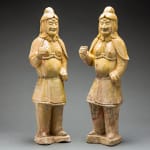Sui Pair of Glazed Terracotta Military Officers, 581 CE - 618 CE
Glazed Terracotta
height 47 cm
height 18 1/2 in
height 18 1/2 in
H.526
Further images
After almost four hundred years of civil war and division, Yang Jian succeeded in reunifying north and south under one authority, the Sui Dynasty. However, despite its brief duration, lasting...
After almost four hundred years of civil war and division, Yang Jian succeeded in reunifying north and south under one authority, the Sui Dynasty. However, despite its brief duration, lasting for the rule of only two emperors, the Sui Dynasty paved the way for the cultural renaissance that would arise during the T’ang Dynasty. Reforms were introduced to wrest power out of the hands of the aristocracy, military, and Buddhist communities. The Confucianist system of selecting government officials from state schools, by means of rigorous examinations, was initiated. Perhaps their most significant program was the construction of the Great Canal, a project that facilitated the movement of people and goods across great distances, aiding in the reunification of China. However, the cost of the Canal bankrupted the empire and ultimately led to its dissolution, coupled with a failed campaign to conquer Korea. The rulers of the T’ang would capitalize on the infrastructure improvements of the Sui and establish one of the greatest empires in the history of China, following the footsteps of the Sui.
Sui Dynasty innovations ushered in the great flowering o tomb object, , production that lasted into the Tang Dynasty. With the reunification of the Chinese proper, Sui artisans were face with an increased demand for elaborate pieces to furnish the interior compound of a burial lay-out that began to look more like a landscape of surface societ rather than a recreation of daily life which characterized the tombs of earlie periods.
Though guardian figurines became the hot product of th day, military figurines persisted to play an important role in the buria procession. These two figurine represent Sui military men, posed in a familiar stance with one arm cocke forward and the other drawn to the side grasping a weapon that no longer exists. Based on the sort of techniques and production methods available at th time, it is assumed that bright colors were applied onto a base of white-bodie ware. Detailed painted work can b seen on the trousers that appear to be blue and red decorative pads covering th knees. The soldiers are protecte head to toe in armor consisting of pectoral plates, a headdress, and a shoulde cape. Their facial features ar sculpted to the finest detail--their curved eyebrows and grimacing mouth expres the tension of men ready to risk their life in battle.
In a realistic representation, these two militar figurines exemplify the transformation of tomb objects, reflecting the strength,
vigor, and wealth of the unified Sui Empire. Tomb figurines once again claim their superior position among Chines classical sculptural forms.
Sui Dynasty innovations ushered in the great flowering o tomb object, , production that lasted into the Tang Dynasty. With the reunification of the Chinese proper, Sui artisans were face with an increased demand for elaborate pieces to furnish the interior compound of a burial lay-out that began to look more like a landscape of surface societ rather than a recreation of daily life which characterized the tombs of earlie periods.
Though guardian figurines became the hot product of th day, military figurines persisted to play an important role in the buria procession. These two figurine represent Sui military men, posed in a familiar stance with one arm cocke forward and the other drawn to the side grasping a weapon that no longer exists. Based on the sort of techniques and production methods available at th time, it is assumed that bright colors were applied onto a base of white-bodie ware. Detailed painted work can b seen on the trousers that appear to be blue and red decorative pads covering th knees. The soldiers are protecte head to toe in armor consisting of pectoral plates, a headdress, and a shoulde cape. Their facial features ar sculpted to the finest detail--their curved eyebrows and grimacing mouth expres the tension of men ready to risk their life in battle.
In a realistic representation, these two militar figurines exemplify the transformation of tomb objects, reflecting the strength,
vigor, and wealth of the unified Sui Empire. Tomb figurines once again claim their superior position among Chines classical sculptural forms.
Literature
V17













